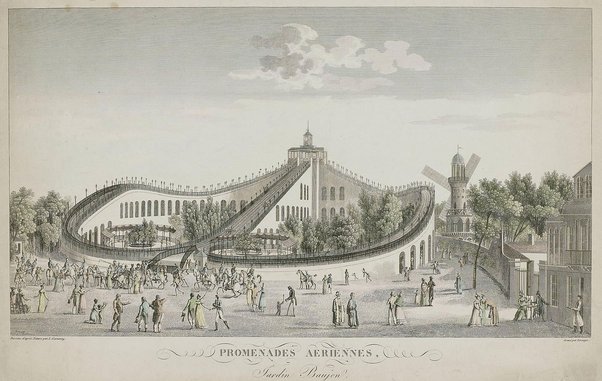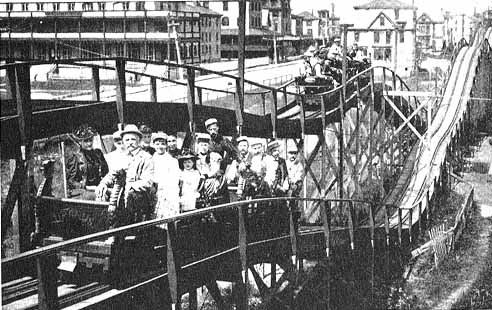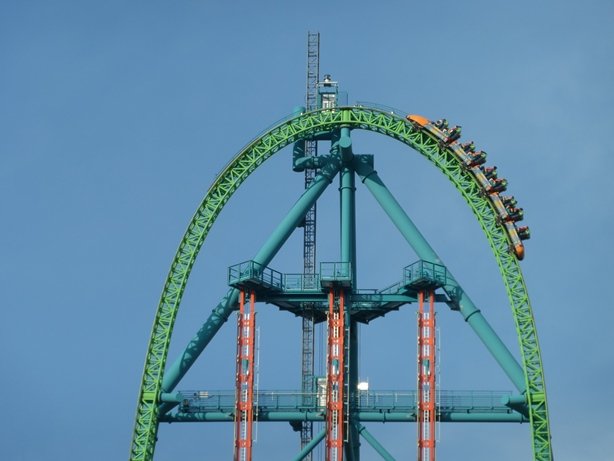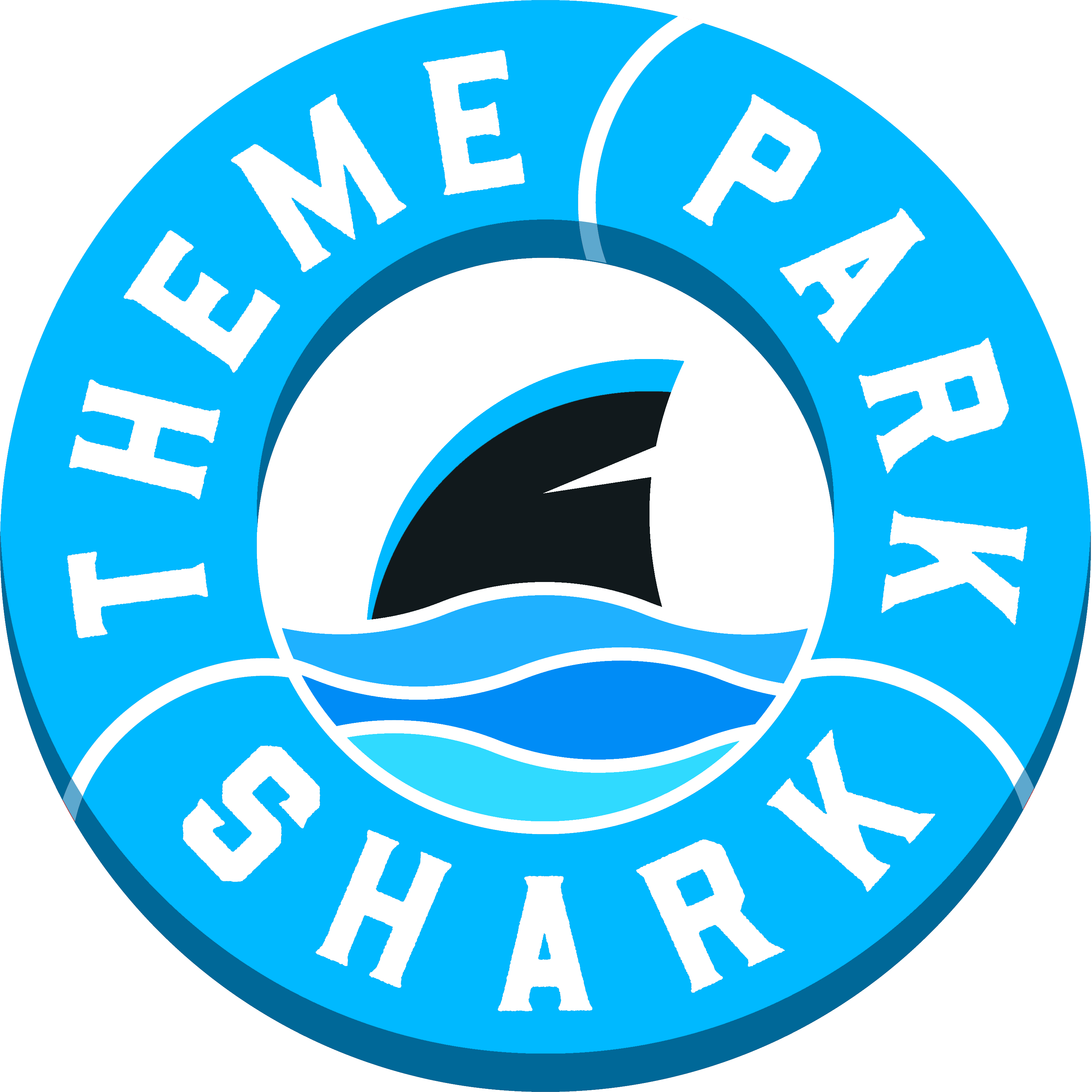There are several parts to the story of the roller coaster’s origin; from the most primitive contraption that one can conceivably call a coaster to the first roller coaster in America, there is a rich and detailed history behind the attraction that has made its home at so many American Theme Parks.
In 1817, over 200 years ago, the roller coaster made its historical debut in Paris, with the The Promenades-Aériennes, or the ‘Aerial Walk.’ It was an incredibly popular attraction at Parc Beaujon, the amusement park in which it resided. This ride, owned by French banker Nicolas Beaujon, featured two circular tracks to which wheeled carts were firmly attached, allowing guests to coast down at speeds of up to 40 mph.

[Pictured above, The Aerial Walks, Baujon Garden, Honored by the Presence of Her Majesty, August 2, 1817, illustration by Louis Garneray, c. 1817]
This historical first drew its inspiration from downhill sled rides in Russia where riders would race down specially-constructed wooden hills covered in ice on unsecured sleds or blocks of ice. These attractions, commissioned by Catherine the Great in the 17th century, were the precursor to the Promenades-Aériennes and the model upon which the French attraction would improve. This attraction, though over 200 years old, is still recognizable as a roller coaster by modern standards and even featured a mechanized lift function later in its life.
However, what America -and indeed, the global attractions industry – recognizes as a modern roller coaster was introduced in 1884.
The Gravity Switchback Railway, built by LaMarcus Adna Thompson (the “Father of Gravity”) for the Coney Island amusement park located on the piers of Brooklyn, New York, is America’s first roller coaster. This attraction, operating between two fifty-foot departure towers, allowed guests to coast downhill along a 600-ft track at a breakneck 6 mph.
Seems like a bit of a downgrade, doesn’t it?
The patrons at Coney Island didn’t seem to think so! With an asking price of five cents per ride, the Gravity Switchback Railway was a hit, raking in over six hundred dollars a day. In 1884, $600 would have the same purchasing power as $19,235 today, which puts into perspective just how lucrative this attraction was for Coney Island.

[Pictured above, Coney Island’s Gravity Switchback Railway, c. 1884]
This attraction opened on June 16th, 1884, and set the precedent for amusement attractions in America. While not as technologically advanced as its modern-day descendants, the Gravity Switchback Railway made a massive impact in the amusement industry. Though the exact date that the Gravity Switchback Railway closed, it’s reported to have had a short run – a few seasons at most.
Considering how the multi-million dollar steel coasters of today tend to hang around for a decade or more, this short-lived attraction can seem strange. However, advancements in design happened within the year – seeing America’s first complete-circuit coaster featured in the Serpentine Railway design in 1885, pioneered by Charles Alcoke.
This innovation in coaster technology created the footprint of modern roller coasters, and allowed the gravity-pulled attractions of its era to loop continuously without the need for attendants to retrieve the cars.
With over 6,000 roller coasters in the world today according to the World Census of the Roller Coaster Database, and over 200 years of thrills and amusement, this cornerstone of the amusement industry deserves its own national holiday.
With so many manufacturers of coaster systems, the variety and innovation is endless. Intamin, B&M, RMC, Mack, Gerstlauer, and Vekoma are some of the biggest, most famous names in the coaster industry, but even companies like Kuka – mostly known for their work creating robotic arms for manufacturing and assembly lines – have thrown their hat in the ring, producing unique and versatile coaster systems that are being seen at major theme parks more frequently in the modern era, where themed entertainment sits at the intersection of thrill, immersion, and innovation.
Still, despite the wealth of variety coaster enthusiasts get to enjoy, there are still individual coasters that deserve recognition for the feats of engineering they pull off. For as many roller coasters as we have in the world – each with its own thrills and dedicated fans – there are a select few that can truly claim to be the tallest or the fastest out there.
To celebrate roller coasters and all the screams they’ve brought us in the last two hundred years, lets take a look at some of the most impressive records holders currently in operation around the world.
Recorded as the fastest coaster currently in operation anywhere in the world is Kingda Ka at Six Flags Great Adventure in Jackson, New Jersey, US. Kingda Ka opened in May of 2005 and clocks in at a breakneck 128 mph.
Kingda Ka also holds the record for the tallest operating coaster in the world, with its tallest point reaching 456 feet above ground. That’s over twice the height of the tallest coaster in Orlando!
If height or speed aren’t your thing, the world’s longest coaster track can be found at Nagashina Spa Land in Kuwana Mei, Japan, on the 8,133 foot long Steel Dragon 2000, which opened in August of 2000. While it may not be a record holder in the speed or height category, this attraction definitely holds its own with speeds of up to 95 mph and a 300-foot drop on a ride that lasts a whopping four minutes due to its impressive track length.

But it’s not just height or speed or run time that make a coaster thrilling. In Staffordshire, England in the UK is a coaster at the Alton Towers park has two dive loops, five corkscrews, and a reverse sidewinder. If you’re not familiar with the terminology behind each of these thrilling maneuvers, don’t worry! Just strap in and hold on, because the Smiler has a whopping fourteen inversions that will leave you thoroughly marmalised.
No matter what your favorite roller coaster is – whether it’s a record holder, steel, wood, kiddie, or suspended coaster – the roller coaster is a staple in the modern landscape of amusement entertainment and theme parks world wide. This August 16th, don’t forget to celebrate your favorite roller coaster worldwide!









